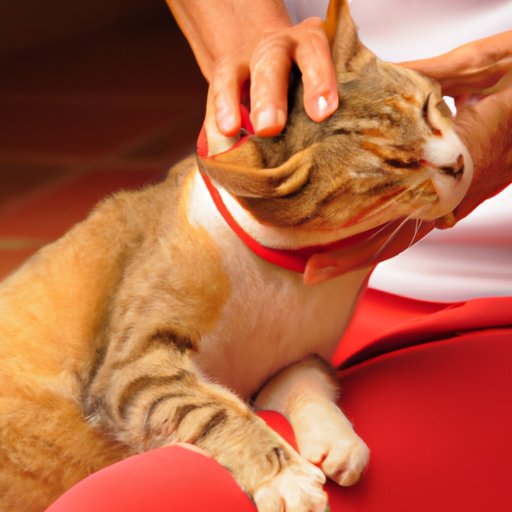I. Introduction
Cats are fascinating creatures, capable of displaying different behaviors that can pique our interest. One of the behaviors that can catch any cat owner’s attention is kneading or biscuit-making. If you own a cat, you have probably encountered your furry friend pressing on you with their paws and making a massaging motion. What does it mean, though, when your cat makes biscuits on you? In this article, we’ll explore the science, meaning, and benefits of cat kneading behavior.
II. Kneading Explained: The Science Behind Why Cats Make Biscuits on Their Humans
Kneading refers to the rhythmic massaging motion that cats make with their paws, pushing in and out against a soft surface. It’s a common behavior among cats of different ages and breeds that goes back to their earliest lives with their mothers. Cats knead because it’s instinctual behavior; they have inherited it from their wild ancestors, who kneaded to soften surfaces before lying down.
There are a few scientific explanations as to why cats knead. One reason is that kneading releases happy hormones or endorphins, providing a form of stress relief. Another is that it’s a way for cats to mark their territory with the scent glands on their paws. Also, kneading may help cats relax muscles that could become stiff if they don’t move much.
III. The Hidden Meaning of Your Cat’s Biscuit-Making Behavior
Aside from the physical reasons, cat kneading can also have emotional and psychological motivations. When cats knead their humans, it’s often a sign of comfort. Kittens knead their mothers during nursing to stimulate milk production and show contentment and security. Hence, it’s possible for adult cats to knead their human as a way of showing affection and comfort.
In addition, kneading can indicate your cat’s trust in you. As cats are sensitive creatures, they don’t knead around anyone they deem threatening or unfriendly. If your cat is kneading you, they feel safe and secure around you.
IV. The Comforting Reason Why Your Cat Makes Biscuits on You
According to experts, cat kneading is linked to the bond between cats and humans. The rhythmic motion can provide a calming effect on both the cat and the human. For cats, the act of kneading can be associated with nursing, which can evoke a sense of comfort and safety. In return, humans can feel comforted and relaxed by their cat’s gentler nature.
V. From Instinct to Affection: Understanding Why Cats Make Biscuits
Cats kneading behavior is instinctive, as mentioned. But it can also be interpreted as a form of affection. It’s the cat’s way of expressing their feelings towards their human. Since cats are not verbal creatures, kneading is their way of showing love and appreciation. Hence, if your cat kneads you, it is a clear sign that they hold you in high regard.
VI. Exploring the Fascinating Origins of Your Cat’s Biscuit-Making Habit
Household cats are descendants of wild cats and have been domesticated for thousands of years. Over time, the kneading behavior has evolved from a necessity to a behavioral trait. It could explain why kneading persists as a common feline behavior regardless of age and breed. It’s fascinating that even with the shift from wild to domestic life, the kneading instinct was not lost but passed on from one cat generation to the next.
VII. The Surprising Benefits of Your Cat’s Kneading Behavior
Aside from showing affection and comfort, cat kneading behavior provides various physical and emotional benefits to both cats and humans. The repetitive motion can help with muscle relaxation and relieve tension, leading to better posture and flexibility. Emotionally, kneading can provide both the human and the cat with a sense of security, warmth, and happiness. Cats are known for their therapeutic behavior that can help with anxiety and depression, and kneading is no exception.
VIII. What Your Cat’s Biscuit-Making Says About Your Relationship
Cat kneading is more than a mere physical action; it can reflect the relationship between a cat and its human. For instance, if your cat kneads you more than other members of your family, it shows that they hold a special place in their heart for you. If your cat kneads while purring or looking at you, it’s a sign of affection and contentment. On the other hand, if your cat doesn’t knead on you, it could be that they don’t trust you enough yet or don’t have an attachment to you.
IX. Conclusion
Cat kneading is one of the many behaviors that make felines unique and fascinating. Understanding why cats knead provides us insight into their instinct, emotions, and relationship with humans. Kneading is a sign of affection and trust that can provide physical and emotional benefits to both cats and humans. If your cat makes biscuits on you, it’s worth appreciating their gentleness and enjoying the bond that comes with it.
Tips for understanding and dealing with cat kneading behavior
– Provide a soft surface to knead, such as a blanket or towel.
– Watch your cat’s behavior; if they seem uncomfortable or agitated, stop them from kneading.
– Offer positive reinforcement through petting, praising, or treats.
– Don’t punish them for kneading. It’s a natural behavior.
– Give your cat enough exercise and playtime to reduce their kneading frequency.
